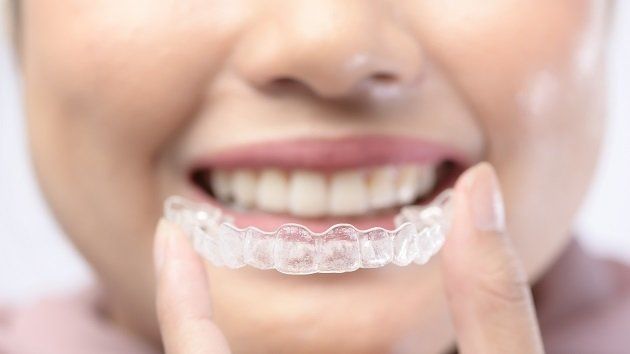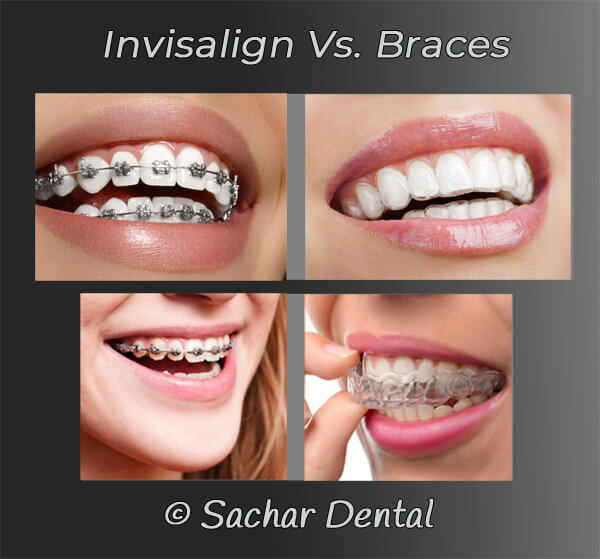Keeping Oral Health While Utilizing Invisalign: Tips for a Smooth Experience
Keeping Oral Health While Utilizing Invisalign: Tips for a Smooth Experience
Blog Article
Invisalign vs. Typical Dental braces: Which Choice Is Right for You?
When thinking about orthodontic treatment, the choice between Invisalign and typical dental braces provides numerous essential elements that warrant mindful examination. Invisalign offers a very discreet choice with detachable aligners, while standard dental braces supply a much more visible yet effective option for severe misalignment.
Overview of Therapy Options

In contrast, traditional dental braces consist of metal brackets and cables that are adhered to the teeth. This approach applies constant pressure gradually to achieve positioning. While reliable for complex orthodontic concerns, traditional braces call for routine sees for adjustments and can posture difficulties in keeping oral hygiene because of the difficulty of cleaning around braces and cords.
Both choices have their merits, and the choice often depends upon certain dental problems, way of living choices, and client compliance. Eventually, consulting an orthodontic expert is vital for identifying the most ideal therapy strategy tailored to specific needs. Understanding the nuances of each choice can substantially affect the total success of orthodontic treatment.
Visual Considerations
A substantial aspect influencing the selection in between Invisalign and standard braces is the visual charm each therapy uses. Invisalign aligners are crafted from clear plastic, making them practically unnoticeable when put on.
In comparison, conventional dental braces include steel brackets and cords, which can be more obvious. While innovations in orthodontic innovation have caused the growth of smaller braces and colored elastics, traditional dental braces still maintain an even more conspicuous account. For some people, the exposure of dental braces may deter them from seeking essential therapy.
Inevitably, the option in between Invisalign and typical dental braces may rest on individual preferences pertaining to looks. Patients that focus on discernment often favor Invisalign, while those that are less concerned about exposure might select typical braces. Comprehending the visual effects of each choice is essential for making an informed decision that lines up with one's way of living and choices.
Convenience and Convenience

In regards to benefit, Invisalign aligners are removable, enabling patients to appreciate their preferred foods without limitation and maintain optimum oral hygiene. Cleaning and flossing are simplified, as the aligners can be taken out throughout these routines, whereas traditional dental braces need careful steering around cords and brackets.
In comparison, conventional dental braces necessitate routine changes, making them less practical for those with busy routines. On the whole, the comfort and comfort of Invisalign make it an enticing choice for lots of people seeking orthodontic therapy.
Therapy Duration and Efficiency
While both Invisalign and typical dental braces are efficient in fixing oral imbalances, the duration Homepage of treatment can vary dramatically in between the 2 options. Generally, Invisalign treatment can take anywhere from 12 to 18 months, depending upon the intricacy of the situation. The clear aligners function by gradually changing teeth right into their desired positions, and normal follow-ups with an orthodontist help make certain progress remains on the right track.
In comparison, standard braces usually need a longer dedication, typically varying from 18 months to three years. This results from their fixed nature and using cords and braces, which can be extra efficient for extreme imbalances and intricate situations (Invisalign). The therapy performance of typical braces is well-documented, as they permit precise adjustments and better control over tooth activity
Inevitably, the selection between Invisalign and typical dental braces might rest on both the expected therapy period and the certain oral issues at hand. Consulting with an orthodontist is critical, as they can offer tailored referrals based on individual demands, making certain the Going Here picked method straightens with wanted durations and outcomes.
Price Comparison and Insurance Policy Choices
Price plays a significant duty in the decision-making procedure for people taking into consideration orthodontic treatment, whether going with Invisalign or traditional braces. Typically, the price of Invisalign ranges from $3,000 to $8,000, while traditional braces generally set you back in between $2,000 and $6,000. Variables affecting these expenses consist of the complexity of the instance, the duration of treatment, and geographical area.
Insurance policy coverage can dramatically impact out-of-pocket costs. Numerous dental insurance plans give partial protection for orthodontic treatments, however the specifics can vary widely. It is crucial for patients to review their insurance coverage to determine the degree of insurance coverage for either alternative. Usually, standard dental braces may be more frequently covered by insurance plans contrasted to Invisalign, which some insurers categorize as an aesthetic procedure.
Furthermore, numerous orthodontic techniques use adaptable layaway plan, making both therapy choices extra easily accessible. People must inquire about potential funding choices and discount rates for in advance payments. Evaluating the overall price, including insurance coverage advantages and layaway plan, is crucial for making an informed choice that aligns with both aesthetic choices and budget plan factors see this website to consider.

Conclusion
In recap, the option between Invisalign and traditional braces pivots on numerous factors, including aesthetic preferences, comfort, treatment period, and expense. Invisalign supplies a very discreet, detachable choice that facilitates oral hygiene and dietary adaptability, while standard dental braces might be better for complicated dental concerns and often come at a lower rate factor. Ultimately, appointment with an orthodontist is vital to examine private situations and figure out one of the most appropriate treatment option for attaining ideal dental positioning.
When thinking about orthodontic treatment, the selection between Invisalign and typical braces provides numerous crucial aspects that merit cautious evaluation.Comparing Invisalign and standard dental braces discloses distinctive treatment alternatives for orthodontic modification.While both Invisalign and typical braces are efficient in dealing with dental misalignments, the duration of treatment can vary significantly between the two alternatives.Expense plays a considerable function in the decision-making process for people taking into consideration orthodontic treatment, whether deciding for Invisalign or standard braces.In recap, the choice between Invisalign and standard braces pivots on numerous variables, including visual preferences, comfort, therapy period, and cost.
Report this page